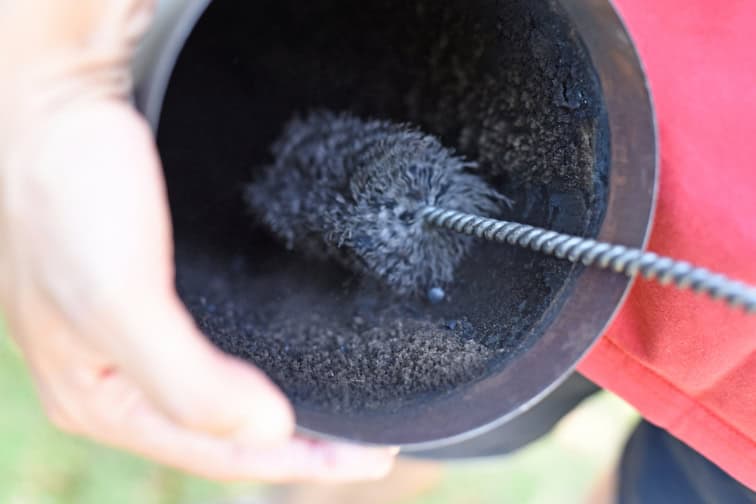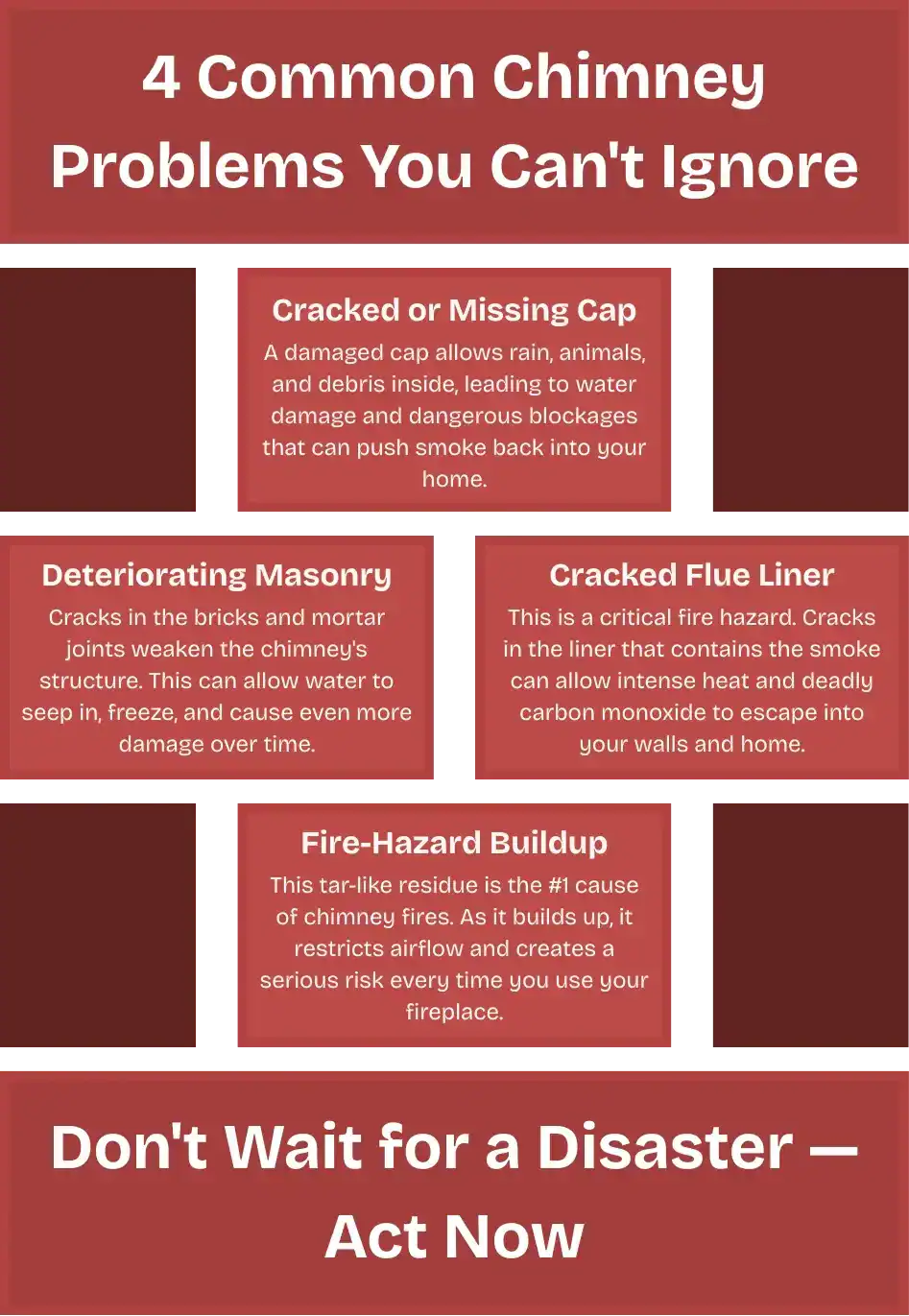
Summary:
Professional chimney cleaning starts before we even touch your fireplace. We begin with a complete exterior assessment, looking for cracked masonry, deteriorating mortar, or damaged chimney caps that could signal bigger problems.
Inside your home, we’ll set up protective coverings around your fireplace area. You won’t find soot on your furniture or floors when we’re finished – that’s the difference between professional service and DIY attempts.
The actual cleaning process involves specialized brushes and industrial vacuums designed specifically for chimney work. But here’s what makes it valuable: our experienced technicians know what to look for while we’re cleaning.

Creosote removal is where the real safety work happens. This flammable residue builds up every time you burn wood, and it’s more dangerous than most homeowners realize.
Stage 1 creosote looks like black flakes and brushes away relatively easily. If you burn dry, seasoned wood and maintain good airflow, this is typically what you’ll see. Regular cleaning keeps it at this manageable level.
Stage 2 creosote becomes tar-like and requires specialized tools to remove. This happens when fires burn too cool or when moisture is present. At this stage, you’re looking at increased fire risk and more complex removal.
Stage 3 creosote is the nightmare scenario. It forms a hard, glazed coating that can weigh over 100 pounds in severe cases. This concentrated fuel creates extreme fire hazards and often requires chemical treatment or even flue liner replacement.
We use different approaches for each stage. We have rotary tools, specialized chemicals, and the experience to know when creosote buildup has moved beyond simple cleaning into safety emergency territory.
Most importantly, we can tell you why creosote is building up in the first place. Are you burning green wood? Is your damper not opening fully? Is there a draft problem? Fixing the root cause prevents future buildup.
While we’re cleaning, we’re also conducting a thorough safety inspection. This isn’t an upsell – it’s the most valuable part of our service.
Your flue liner gets careful attention. Cracks or gaps in clay tiles or metal liners can allow dangerous gases to escape into your home. These same gaps let heat reach combustible materials in your walls. Small cracks found early prevent major problems later.
The damper system gets tested for proper operation. A stuck damper affects efficiency, but more importantly, it can allow animals, debris, or weather into your home when you’re not using the fireplace.
Masonry joints and brickwork are evaluated for water damage. Providence County’s freeze-thaw cycles are particularly hard on chimney masonry. Catching deterioration early prevents expensive structural repairs.
Your chimney crown and cap receive attention too. These components protect your entire chimney system from weather damage. Problems here often lead to interior damage that’s much more expensive to repair than the original issue.
Want live answers?
Connect with a Certified Chimney Inspections expert for fast, friendly support.
The consequences of neglected chimney maintenance go far beyond poor fireplace performance. Understanding these risks helps you see why professional cleaning isn’t optional.
Chimney fires burn at temperatures exceeding 2000°F. They can crack flue liners, ignite nearby combustibles, and spread to your home’s structure within minutes. Even “small” chimney fires can cause thousands of dollars in damage you might not notice immediately.
Carbon monoxide poisoning represents another serious threat. This odorless, colorless gas can cause illness or death before you realize there’s a problem. Blocked or damaged chimneys can’t properly vent these dangerous gases outside your home.
Your homeowner’s insurance policy likely requires regular chimney maintenance to maintain coverage for fire damage claims. Insurance companies understand that preventable maintenance issues dramatically increase their risk.
Most insurance providers expect annual chimney inspections and cleanings for homes with active fireplaces. If a chimney fire occurs and investigators find evidence of neglected maintenance, your claim could be denied entirely.
Documentation becomes crucial here. We provide detailed reports showing compliance with safety standards and manufacturer recommendations. This documentation protects your coverage and demonstrates responsible homeownership.
Local building codes in Providence County also address chimney maintenance requirements. These aren’t arbitrary rules – they exist to protect public safety and property values throughout the community.
Regular professional service ensures your chimney meets current safety standards. It also identifies code violations that might affect your home’s resale value. Buyers increasingly request chimney inspections, and documented maintenance history can set your property apart in competitive markets.
The cost of regular maintenance pales in comparison to emergency repairs, insurance deductibles, or – worst case – rebuilding after a fire. Professional cleaning typically costs between $150-$350, while chimney fire damage often runs into tens of thousands of dollars.
Certain symptoms indicate your chimney needs professional attention before your next scheduled cleaning. Recognizing these warning signs can prevent dangerous situations and expensive emergency repairs.
White staining on your chimney’s exterior bricks signals water infiltration problems. This efflorescence occurs when moisture carries mineral salts to the surface. The water damage causing this staining often extends far beyond what’s visible.
Smoke entering your room instead of going up the chimney indicates serious problems with your flue or damper system. Never ignore this warning – it suggests dangerous gases might also be entering your living space.
Rust on your damper or firebox components shows moisture problems that compromise your chimney’s structural integrity. Persistent dampness also creates conditions for mold growth in hidden areas around your chimney.
Animals or birds in your chimney create immediate safety hazards. Their nests block proper ventilation and create fire risks. Professional removal and prevention measures protect both wildlife and your home.
Strong odors from your fireplace during warm weather often indicate creosote buildup or moisture problems. These smells can permeate your home and signal conditions that support dangerous situations.
Your chimney cleaning process should involve much more than removing soot and debris. It’s a comprehensive safety evaluation that protects your family and your most significant investment.
We bring specialized tools, training, and experience that ensure thorough cleaning and accurate problem identification. We understand local conditions in Providence County and can spot issues that untrained eyes miss.
The modest cost of regular maintenance prevents expensive emergency repairs and protects your insurance coverage. More importantly, it provides peace of mind knowing your chimney system operates safely and efficiently. For Providence County homeowners who value professional service and transparent communication, we provide the expertise and reliability you need to keep your family safe.